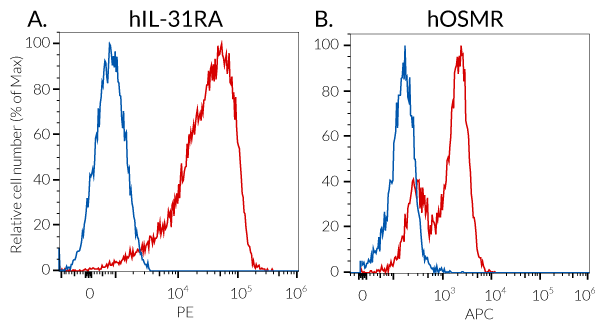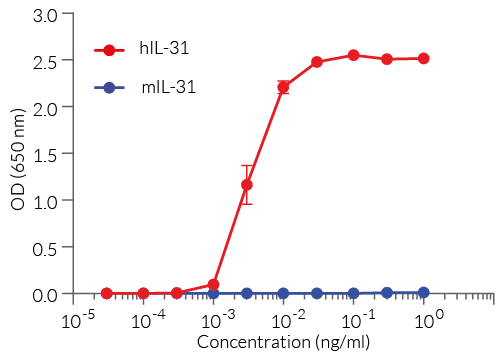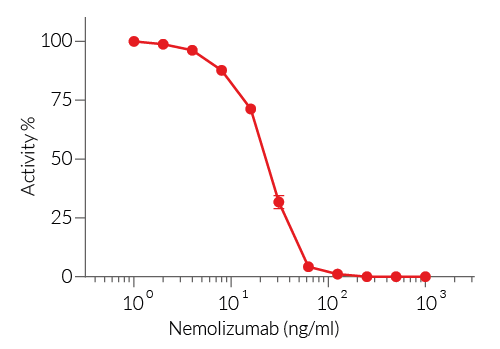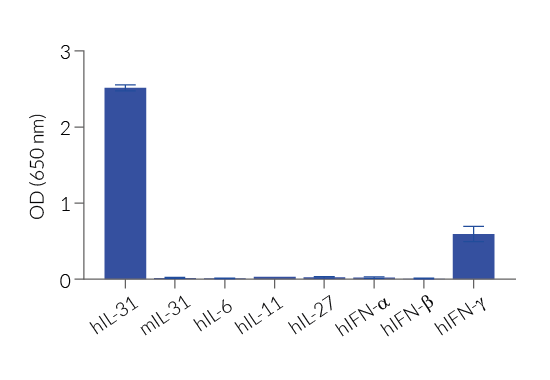IL-31 Reporter HEK 293 Cells
| Product | Unit size | Cat. code | Docs. | Qty. | Price | |
|---|---|---|---|---|---|---|
|
HEK-Blue™ IL-31 Cells Human IL-31 Reporter Cells |
Show product |
3-7 x 10e6 cells |
hkb-il31
|
|||
|
HEK-Blue™ IL-31 vial Additional cell vial |
Show product |
3-7 x 10e6 cells |
hkb-il31-av
|
![]() Cytokine offer: For each cytokine reporter cell line purchased, get a free vial of the matching cytokine.
Cytokine offer: For each cytokine reporter cell line purchased, get a free vial of the matching cytokine.
IL-31 responsive STAT5-SEAP reporter assay
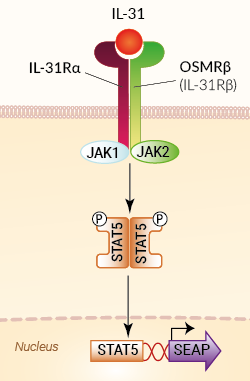
Signaling pathway in HEK-Blue™ IL-31 cells
InvivoGen also offers:
HEK-Blue™ IL-31 cells are designed to monitor human IL-31-induced STAT5 stimulation or inhibition. This colorimetric bioassay can be used for screening activatory molecules, such as engineered cytokines, or inhibitory molecules, such as neutralizing antibodies.
HEK-Blue™ IL-31 cells respond specifically to recombinant human IL-31. The reliable and consistent performance of HEK-Blue™ IL-31 cells makes them suitable for release assays of therapeutic molecules that inhibit IL-31 signaling, such as Nemolizumab, a monoclonal antibody targeting the IL-31Rα subunit of the IL-31 receptor (see figures).
Key features
- Readily assessable STAT5-SEAP reporter activity
- Convenient readout using QUANTI-Blue™ Solution
- High sensitivity to human (h) IL-31 activity
- Stability guaranteed for 20 passages
Applications
- Therapeutic development
- Drug screening
- Release assay
Interleukin-31 (IL-31) is a cytokine that plays a role in early protective inflammatory processes, likely regulating alarmins in damaged mucosal tissues. IL-31 is strongly involved in chronic inflammation in different skin diseases, including atopic dermatitis and allergic contact dermatitis.
All InvivoGen products are for internal research use only, and not for human or veterinary use.
Back to the topSpecifications
Cell type: Epithelial
Tissue origin: Human Embryonic Kidney
Target: IL-31
Specificity: Human
Reporter gene: SEAP
Antibiotic resistance: Blasticidin, Hygromycin B, Zeocin®
Detection range: 2 pg/ml - 1 ng/ml (hIL-31)
Growth medium: Complete DMEM (see TDS)
Growth properties: Adherent
Mycoplasma-free: Verified using Plasmotest™
Quality control: Each lot is functionally tested and validated.
Back to the topContents
HEK-Blue™ IL-31 Cells (hkb-il31)
- 1 vial containing 3-7 x 106 cells
- 2 x 1 ml HEK-Blue™ Selection (250X concentrate)
- 1 ml Normocin® (50 mg/ml)
-
1 ml of QB reagent and 1 ml of QB buffer (sufficient to prepare 100 ml of QUANTI-Blue™ Solution, a SEAP detection reagent)
HEK-Blue™ IL-31 vial (hkb-il31-av)
- 1 vial containing 3-7 x 106 cells
![]() Shipped on dry ice (Europe, USA, Canada, and some areas in Asia)
Shipped on dry ice (Europe, USA, Canada, and some areas in Asia)
Notification: Reference #hkb-il31-av can only be ordered together with reference #hkb-il31.
Back to the topDetails
Cell line description
HEK-Blue™ IL-31 cells were generated by stable transfection with the genes encoding for the human IL-31 receptor (IL-31Rα and human OSMRβ (oncostatin M receptor β) chains), STAT5b, and a STAT5-inducible secreted embryonic alkaline phosphatase (SEAP) reporter. The binding of IL-31 to its receptor triggers a signaling cascade leading to the activation of STAT5 and the subsequent production of SEAP.
HEK-Blue™ IL-31 cells detect human IL-31 but not murine IL-31 (see figures). Of note, they also respond to hIFN-γ. However, they do not respond to hIFN-α and hIFN-β (see figures).
IL-31 background
The cytokine interleukin 31 (IL-31) belongs to the Type I/II cytokine receptor family, and more specifically to the IL-6/gp130 family. IL-31 signals through a heterodimeric receptor comprised of the gp130-like subunit IL-31Rα and the OSMRb (oncostatin M receptor) subunit. The binding of IL-31 to its receptor triggers activation of the JAK/STAT, Akt/PI3K, and MAPK signaling pathways [1,2]. IL-31 receptor complex is expressed in epithelial, neuronal as well as immune cells. Little is known about the physiological function of IL-31. It is mainly secreted by IL-4-activated T cells, thereby contributing to Th2-weighted inflammation [1,2]. Several reports indicate that IL-31 is implicated in disorders such as atopic dermatitis, asthma, and inflammatory bowel disease [1,2]. Of note, IL-31 appears to be a critical cytokine involved in neuro-immune communication through the mediation of inflammatory itch [1,2]. Targeting the IL-31 pathway is a promising therapeutic option for dermatologic and non-dermatologic diseases with enhanced IL-31 expression [1,2].
References:
1. Bagci I.S. and Ruzicka, T., 2018. IL-31: A new player in dermatology and beyond. J. Allergy Clin Immunol. 141(3):858-866.
2. Datsi A., et al., 2021. Interleukin-31: The “itchy” cytokine in inflammation and therapy. Allergy. 76:2982-97.






